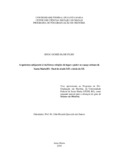| dc.creator | Blois Filho, Hugo Gomes | |
| dc.date.accessioned | 2019-02-28T19:45:27Z | |
| dc.date.available | 2019-02-28T19:45:27Z | |
| dc.date.issued | 2018-07-30 | |
| dc.identifier.uri | http://repositorio.ufsm.br/handle/1/15818 | |
| dc.description.abstract | This work entitled Architecture underlying the railroad: place and power relations in the urban space of Santa Maria/RS – end of the XIX’s and the start of XX’s century, was aimed to analyze the power relations that interacted/interfered in the constitution of the railroad space in the city of Santa Maria/RS, whose occupation took place at the end of the 19th century. For that, the analysis proceeds from the localization phenomenon with the arrival of the railroad and consequent characterization of three places: Rio Branco Avenue – main axis connection from the urban center to the Railway Station; the “Vila Operária Belga” – a housing nucleus designed to house the administrative workers of the railroad and, finally, the “Itararé” neighborhood where were installed the workers responsible for maintaining the railroad, called "tucos" . The studies and analysis are based on authors such as Michel Foucault and Pierre Bourdieu and on the understanding of the relations of symbolic power that are established between different social groups. The analysis is structured in reference to the existing iconography, capable of revealing the architecture produced in the period, as well as its relations with the urban form. It is concluded that the architectural production, produced by the railroad workers group and the urban elite of Santa Maria, is underlying through the building elements related to the railroad deployment. Its underlying reveals us that the railroad was the pioneer, not just on Santa Maria economic development, but it also resulted in the consolidation of a differentiated architecture on its symbolic assumption. | eng |
| dc.language | por | por |
| dc.publisher | Universidade Federal de Santa Maria | por |
| dc.rights | Attribution-NonCommercial-NoDerivatives 4.0 International | * |
| dc.rights.uri | http://creativecommons.org/licenses/by-nc-nd/4.0/ | * |
| dc.subject | Arquitetura | por |
| dc.subject | História | por |
| dc.subject | Lugar | por |
| dc.subject | Relações de poder | por |
| dc.subject | Espaço ferroviário | por |
| dc.subject | Architecture | eng |
| dc.subject | History | eng |
| dc.subject | Place | eng |
| dc.subject | Power relations | eng |
| dc.subject | Railroad space | eng |
| dc.title | Arquitetura subjacente à via férrea: relações de lugar e poder no espaço urbano de Santa Maria/RS - final do século XIX e início do XX | por |
| dc.title.alternative | Architecture underlying to railroad: place and power relations in Santa Maria/RS urban space – end of the xix’s and the start of xx’s century | eng |
| dc.type | Tese | por |
| dc.description.resumo | Este trabalho intitulado Arquitetura subjacente à via férrea: relações de lugar e poder no espaço urbano de Santa Maria/RS – final do século XIX e início do XX, vinculado à linha de Pesquisa Memória e Patrimônio, do Programa de Pós-Graduação em História da Universidade Federal de Santa Maria, objetivou analisar as relações de poder que interagiram/interferiram na constituição do espaço ferroviário na cidade de Santa Maria/RS, cujo processo de ocupação deu-se no final do séc XIX. Para tanto, a análise procede, a partir do fenômeno de lugarização, com a chegada da via férrea e consequente caracterização de três lugares: a Av. Rio Branco – principal eixo de ligação do centro urbano à Estação Ferroviária; a Vila Operária Belga – núcleo habitacional destinado a abrigar aos trabalhadores administrativos da ferrovia e, por último, o Bairro Operária Itararé local onde se instalaram aos trabalhados, chamados de “tucos”, responsáveis pela manutenção da via férrea. A análise se baseia em autores como Loius Cloquet, Michel Foucault e Pierre Bourdieu e no entendimento referente às relações de poder simbólico que se estabelecem entre diferentes grupos sociais. A análise se estrutura em referenciais da iconografia existente, capazes de revelar a arquitetura produzida no período, bem como as suas relações com a forma urbana. Conclui-se que a produção arquitetônica, produzida pelo conjunto de trabalhadores da viação férrea e elite urbana santa-mariense, está subjacente através dos elementos edificados relacionados à implantação da ferrovia. Sua subjacência nos revela que, a ferrovia foi a precursora, não só do desenvolvimento econômico de Santa Maria, como também, resultou na consolidação de uma arquitetura diferenciada em seus pressupostos simbólicos. | por |
| dc.contributor.advisor1 | Santos, Julio Ricardo Quevedo dos | |
| dc.contributor.advisor1Lattes | http://lattes.cnpq.br/6418022027415183 | por |
| dc.contributor.referee1 | Konrad, Glaucia Vieira Ramos | |
| dc.contributor.referee1Lattes | http://lattes.cnpq.br/1194002753412760 | por |
| dc.contributor.referee2 | Padoin, Maria Medianeira | |
| dc.contributor.referee2Lattes | http://lattes.cnpq.br/7863155517478900 | por |
| dc.contributor.referee3 | Oliveira, Ana Lúcia Costa de | |
| dc.contributor.referee3Lattes | http://lattes.cnpq.br/1237287793080184 | por |
| dc.contributor.referee4 | Ramos, Eloisa Helena Capovilla da Luz | |
| dc.contributor.referee4Lattes | http://lattes.cnpq.br/5165417275334692 | por |
| dc.creator.Lattes | http://lattes.cnpq.br/4283135188205332 | por |
| dc.publisher.country | Brasil | por |
| dc.publisher.department | História | por |
| dc.publisher.initials | UFSM | por |
| dc.publisher.program | Programa de Pós-Graduação em História | por |
| dc.subject.cnpq | CNPQ::CIENCIAS HUMANAS::HISTORIA | por |
| dc.publisher.unidade | Centro de Ciências Sociais e Humanas | por |



